This is my favorite pierogi dough recipe – soft, elastic, smells of butter and is easy to roll out. This is the best pierogi dough recipe you’ll find. Below I’m also sharing many tips on how to make the perfect pierogi and answer all the questions you could have.
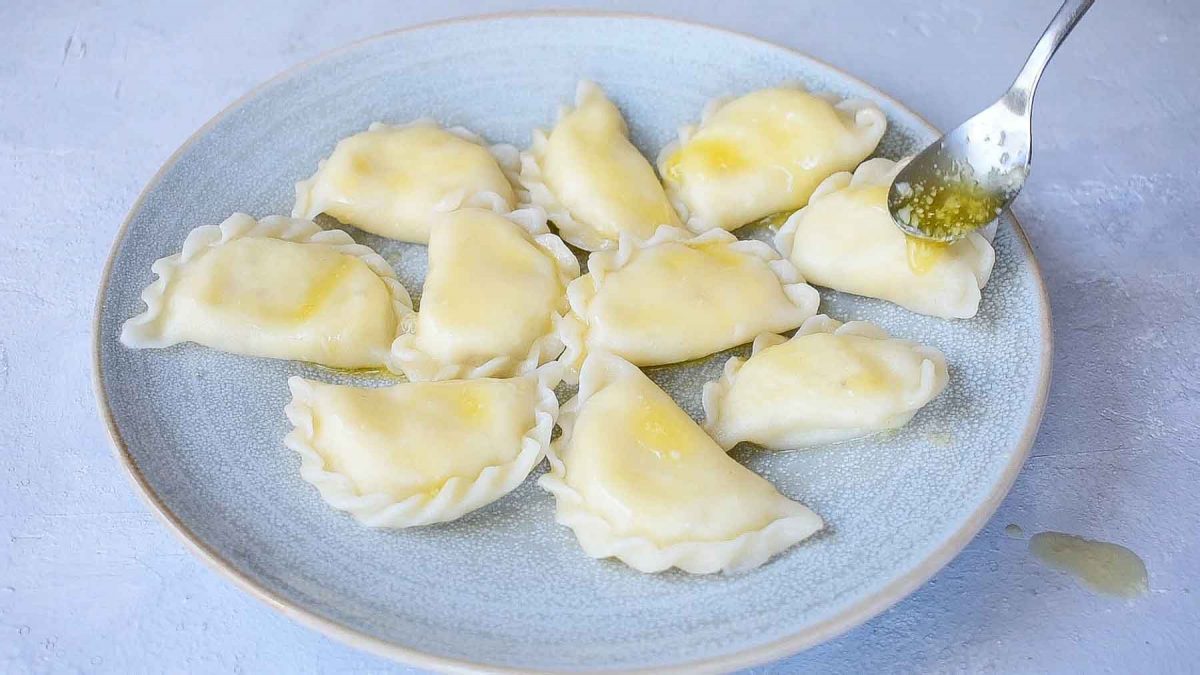
What are pierogi/pierogies?
Pierogi are Polish dumplings, made with unleavened dough and filled with sweet or savory fillings. They are boiled and then sometimes additionally pan-fried.
Pierogi in Poland:
Pierogi are one of the most popular Polish dishes. They are served as a main dish or as a side dish. The most popular pierogi are potato and cheese pierogi, sauerkraut and mushroom pierogi, and pierogi with meat filling (at least in the region where I’m coming from). In summer sweet pierogi (filled with fruits, like strawberries and blueberries) are popular. The flavor combinations are countless.
In Poland you can find small restaurants, where only pierogi are being served, they are filled with many different fillings. Such a restaurant is called ‘pierogarnia’.
Pierogi, Pierogies or Perogies?
Although the word ‘pierogies’ is popularized in English-speaking countries, it is not the true name of these Polish dumplings. The correct name is: singular – 1 pieróg and plural – pierogi. There are no other terms to name it.
What is the difference between pierogi and ravioli:
Ravioli are Italian dumplings, that are wrapped in pasta dough (this dough must contain eggs and is more rich and tough). Italian fillings also differ from traditional pierogi fillings.
Top tips for making the perfect pierogi dough:
- Traditional pierogi dough is easy to make without a recipe (I think no Polish grandmother makes it with a recipe, at least both my grandmothers don’t). The exact recipe is not important here, if the dough is too dry, you need to add some water, if too wet – a little bit of flour. However, it is worth having your favorite recipe and a kitchen scale on hand – the preparation goes much faster, the ingredients are added into a bowl and kneaded together, you don’t need to add additional water or flour.
- One of the most important things is, that the dough is well-kneaded!
- After kneading the dough, let it rest. You can see on my video how much softer and pliable the dough is after it has rested.
- Best water temperature – very hot but not boiling.
- Add some fat – it can be butter (more flavor) or oil.
- Don’t add eggs to the dough (more on that below).
- Dough to filling ratio: it’s very important, but it’s also a matter of taste. I like it when my dough is not very thin but also not very thick. I like to stuff my pierogi with lots of filling but I also like to taste the dough. Experiment what works best for you.
Easy pierogi dough ingredients:
- The best flour to make pierogi – I’m using all-purpose flour.
- Water – it’s important to add hot water to the dough. It makes the dough soft and pliable. You should warm the water with butter until they are very hot, but not boiling (temperature around 80-90 °C / 176-194 °F, that is when the water starts to move and steam). Too hot water will make the dough a little bit more chewy and sticky. Cold water will make the dough harder to roll out and it will be more difficult to shape the pierogi.
- Fat – you could make the dough without it, but it really makes the dough perfect. I’m using butter for its taste but any vegetable oil will also work.
- Salt – also the dough should be seasoned, not only the filling.
- I’ve seen some recipes that call for sour cream. Personally, I’ve never heard of such pierogi dough ingredient and don’t know anyone who is making pierogi with it (at least in Poland). I think it’s more an American or Russian/Ukrainian ingredient. Nowadays though, many home cooks experiment with the ingredients. Authentic Polish pierogi dough recipe call just for flour, water, salt, and optionally some fat and an egg.
Pierogi dough with egg or no egg:
There are two ways of making the pierogi dough – with or without an egg. Many Polish home cooks are arguing, which way is the best.
For me, the perfect pierogi dough is made without the egg. The dough with eggs is a bit tougher in my opinion, but the difference with a well-kneaded dough is not that huge (but there is a difference).
The second reason why I don’t add an egg is that it’s more hygienic – having a small child at home, I usually make a lot of pierogi in one batch, but making a lot of breaks in between. I do not have to worry about washing my hands thoroughly all the time, taking care if the table is well cleaned and watching out if my daughter is eating a dough with a raw egg.
By the way, you should try making pierogi with your kids. Rolling out the dough, cutting out rounds, shaping the pierogi – I think it’s a fascinating activity for every child!
Since this pierogi dough is made without eggs it is suitable for vegetarian diet, vegan diet or dairy-free diet (swap the butter for vegetable oil), or egg-free diet.
What equipment do you need:
- I love making my pierogi dough in my Kitchen Aid but you can also make it by hand. You’ll need to knead the dough for about 10 mins. A food processor can also be used (fitted with the dough blade), but I prefer the stand mixer.
- A rolling pin (or alternatively a wine bottle!). For rolling out the dough you can use a pasta maker (I’m sometimes using my Kitchen Aid pasta attachment). I find that it’s equally easy to roll out the dough by hand and with the pasta maker. Pierogi dough is much more pliable and soft in comparison to pasta dough, which makes it easier to roll out by hand.
- Pierogi cutter / pastry cutter / a cup (preferably with sharp edges). I prefer to use a real pierogi cutter or a pastry cutter – it’s easier to cut out rounds. A regular glass/cup can also be used but I find cutting out round a little bit harder as its edges are more thick and blunt. It would be better to use a glass that has thin, sharp edges if you don’t have a pierogi cutter (both my grandmas are using a regular glass though ;)).
- A pot to cook the pierogi (obviously) and a slotted spoon.
- There are pierogi maker press or pierogi molds available if you search online. I haven’t personally tried them out. Feel free to let me know if there are any that you really like!
How to make pierogi dough – step by step:
STEP 1: Add flour and salt to a large bowl.
STEP 2: Add hot water with butter.
STEP 3: Mix with a wooden spoon until roughly combined.
STEP 4: Knead the dough until smooth and soft.
STEP 5: Prepare the filling.
STEP 6: Roll out the dough and cut out the rounds.
STEP 7: Place the filling on the round.
STEP 8: Shape the pierogi. Ready to be cooked!
How to measure the flour:
In the recipe card below, I provided all possible measurements for the pierogi dough – by volume and by weight. I’m always using a kitchen scale to make my pierogi (and generally to develop the recipes on my website). If you’re weighing your ingredients on a scale your results will be very consistent and the same as mine. It’s really easier, quicker and a kitchen scale is super cheap!
If you’re measuring the flour with measuring cups there is a possibility that you will add more or less flour than I did. You need to check the consistency of the dough and add more flour if it’s too wet and more water if it’s too dry and too tough.
Measuring the flour with measuring cups is unfortunately very inaccurate. 1 US cup of flour can weigh from 120g-140g, depending on how you fill the cup. 20g is a little over 2 tablespoons of flour, so when this recipe calls for 4 cups of flour, you could have added 8 tablespoons more flour which is 1/2 cup! For measuring flour I’m spooning the flour into the measuring cup with a tablespoon and not scooping it with the cup. Level the flour with the back of the knife and don’t tap the cup or press down the flour. Read this article for more information on how to measure flour.
1 US cup is 240 ml. An European cup is 250 ml!
How to roll out the dough with a pasta maker:
Pierogi dough can also be rolled out using a pasta machine. I have a Kitchen Aid pasta roller attachment. I roll out the dough on setting 4. According to the manufacturer’s instructions you need to roll out the dough on each setting until you get to the setting 4. I’m not doing this, pierogi dough without an egg is easier to roll out than an egg dough or pasta dough. To make it possible, the dough must be well sprinkled with flour, at room temperature, slightly rolled out with a rolling pin (to a thickness of approx. ¾ cm / ½ inch) and smooth (otherwise will tear).
How to store pierogi:
To ensure that the cooked pierogi don‘t stick to each other, brush them lightly with melted butter or oil. Store in a tightly-closed container in the fridge for about 2 days. On the next day, it‘s best to pan-fry them with butter until golden.
Freshly cooked pierogi taste best for me, so I usually do this: I prepare only the amount of dumplings that we are going to eat on a given day (about 14 per person, my pierogi are rather small, see the video for the reference). I wrap the rest of the dough tightly in plastic foil and put it in the fridge. I place the rest of the filling (or make filling balls from all of the filling) and also tightly wrap in plastic foil and put in the fridge. On the next day (or even on the third day) I’m preparing the rest of the pierogi.
If I have more time and I’m making more pierogi in one batch, I freeze them or pan-fry with butter the next day.
After removing the dough from the fridge, it is good to slightly warm it up (leave it for about 15-30 minutes on the counter), it will be more elastic (this is optional). The next day the dough can look a little gray in color, but we don‘t mind that.
Freezing tips:
- Cooked pierogi: Place the pierogi apart on a tray, sprinkled well with flour. Freeze until solid. Transfer to containers on plastic bags. Cook like fresh pierogi but take them out once they float on the water surface.
- Uncooked pierogi: Note that not boiled raw pierogi are more likely to crack in a freezer than cooked pierogi. I most often freeze raw pierogi though. Place the pierogi on a tray / wooden board sprinkled well with flour (important, dumplings can easily stick to the tray and tear). Arrange the dumplings so that they do not touch each other. When frozen, transfer them into containers or plastic bags. I cook frozen dumplings just like fresh ones, with the difference that you can cook a smaller amount of them at a time, I cook max. 7-8 frozen pierogi at once (and about 10-12 fresh). When you drop too many frozen pierogi at once it will lower the temperature of the water too much and they will burst.
Store-bought frozen pierogi:
I’ve never eaten store-bought frozen pierogi that tasted amazing (maybe I’m just spoiled with homemade pierogi!). In terms of taste, some of them were not that bad, but for me, the dough is always too thick. This is not surprising since these pierogi are not made by hand. The dough manufactured in a factory need to be thicker so it won’t easily break and can be filled by a machine. Homemade pierogi all the way!
FAQ:
Knead the dough well then let it rest before rolling it out. A good recipe is also important – add butter and hot (but not boiling) water to the dough.
Toss the hot, freshly cooked pierogi with butter or oil until coated on all sides.
You can freeze cooked pierogi or uncooked pierogi. See the instructions above.
There’s no need to do that. You can throw frozen pierogi direct into boiling water.
I like to keep it simple and just pour melted butter over them. Other options are: sauteed/caramelized onions, pan-fried bacon, chopped parsley. Sweet pierogi are often served with sweetened heavy cream/sour cream.
Here you’ll find all my pierogi sauces and toppings ideas.
Yes! You can wrap the filling in shortbread pastry and bake until golden. This kind of pierogi is not that popular but in some regions, people are making baked pierogi.
Your dough was probably not evenly rolled out. Thicker pierogi will be a bit bigger, also when you fill them with more filling. If the dough is of the same thickness you can cook the small and big pierogi the same way.
Cut it into thick strips and use as pasta eg with soup.
It’s probably not well-kneaded, not rested or you’ve used cold water. It’s also possible that you’ve added too much flour – add more water until the dough is smooth and soft.
It really depends on your preferences. I really dislike dough that is rolled out too thick. When the dough is thinly rolled out it literally melts in your mouth after you cook the pierogi.
It will take a minimum of 5 minutes by hand and about 3 minutes in a stand mixer. It can take longer or shorter. You need to pay attention to the dough’ consistency – it should be smooth and soft (check out the video to see the consistency of the dough). It will be even softer when it’s rested.
The dough can be too elastic and shrink as you try to roll it out when it’s not rested. Make sure to rest the dough for about 20-30 minutes, then it should be easy to roll out. This is caused by gluten that is in every type of wheat flour.
Filling recipes:
I have a separate post, where I talk about all the traditional and modern pierogi filling ideas.
Here are the written recipes:
- authentic potato and cheese pierogi (pierogi ruskie) – with potato, twaróg cheese, and onion filling
- potato and cheese pierogi the American way (cheddar pierogi)
- sauerkraut and mushroom pierogi
- spinach and feta pink pierogi (basic pierogi dough is colored with beetroot juice!) with potatoes, onion, feta cheese, and spinach filling
- vegan/vegetarian pierogi with spicy lentil and sun-dried potato filling
- uszka (‘little ears’) pierogi – porcini (wild mushroom) filled mini pierogi for Christmas Eve Borscht
- sweet cheese pierogi
The best pierogi dough recipe + how to make perfect pierogi
Ingredients
- 4 cups flour 500g / 17.5-oz, spoon and leveled, all-purpose flour
- 1 cup + 2.5 Tbsp water 280g / 280ml / 10-oz (to weight on a scale)
- 3 tablespoons butter 1.4 oz/40g, or vegetable oil
- 1 teaspoon salt
Would you like to save this?
Instructions
→ Make the dough:
- Add the flour and salt into a large bowl, mix together.
- In a small saucepan, warm the water with butter until they are very hot, but not boiling (temperature should be around 80-85 °C / 176-185 °F, that is when the water starts to move and steam).
- Pour hot water with butter into the bowl with flour, mix with a wooden spoon until roughly combined.
- Knead the dough using your hands or with a stand mixer fitted with a hook attachment, for about 5 minutes. A food processor can also be used (fitted with the dough blade). The dough should be smooth, soft, and elastic, it shouldn’t stick to your hands. When you follow the recipe (especially if you weigh the ingredients, instead of using measuring cups), the dough should be perfect, but if for some reason it’s not, add some water if it’s too dry, or a little bit of flour if it’s too wet. If the dough already forms a ball, is relatively smooth, but still tough, it means that it’s not ready, it must be further kneaded until soft and elastic (after resting time it will be even softer).
- Wrap the kneaded dough in plastic foil (so it doesn’t dry out), leave to rest for about 30 minutes (it will be easy to roll out).
→ Rolling out, stuffing and shaping the pierogi:
- Divide the dough into 4 parts.
- Onto a lightly floured surface, roll out thinly the first piece of the dough, to a thickness of approx. 2 mm / 1/16 inch. If the dough is hard to roll out, set it aside for about 5-10 minutes to rest.
- Use a cup or a pierogi/pastry cutter to cut out rounds. Place one ball of filling / 1 teaspoon of filling on each round.
- Gather scraps, cover with plastic wrap and set aside.
- Fold the dough over the filling to create a half-moon shape. Press edges together, sealing and crimping with your fingers. Do not leave any gaps or pierogi may open during cooking.
- Place the pierogi apart on a towel lightly sprinkled with flour (this is important, they can stick to the board), cover loosely with a kitchen cloth so that they don‘t dry out.
- Repeat with the remaining dough.
-> Cook the pierogi:
- Bring a large pot of salted water to a boil.
- Cook the pierogi in batches (for a 21 cm /8-inch pot I cook about 10-12 dumplings at a time). When they float to the water surface cook them for 1-2 minutes, then remove from the water with a slotted spoon. The cooking time will depend on the thickness of the dough.
- Drain well and transfer onto a plate. Serve warm, pour over some melted butter.
- Enjoy!
Notes
To ensure that the cooked pierogi don‘t stick to each other, brush them lightly with melted butter or oil. Store in a tightly-closed container in the fridge for about 2 days. On the next day, it‘s best to pan-fry them with butter until golden.
Freshly cooked pierogi taste best, so I usually do this: I prepare only the amount of pierogi that we are going to eat on a given day (about 14 per person). I wrap the rest of the dough tightly in plastic foil and put it in the fridge. I place the rest of the filling (or make filling balls from all of the filling) and also tightly wrap in plastic foil and put in the fridge. On the next day (or even on the third day) I’m preparing the rest of the pierogi. If I have more time and I’m making more pierogi in one batch, I freeze them or pan-fry then with butter the next day.
After removing the dough from the fridge, it is good to slightly warm it up (leave it for about 15-30 minutes on the counter), it will be more elastic (this is optional). The next day the dough will be a little gray in color, but we don‘t mind that. – How to freeze pierogi: Cooked pierogi: Place the pierogi apart on a tray that is sprinkled well with flour. Freeze until solid. Transfer to containers on plastic bags. Cook like fresh pierogi but take them out once they float to the water surface. Uncooked pierogi: Note that not boiled raw pierogi are more likely to crack in a freezer than cooked pierogi. I most often freeze raw pierogi though. Place the pierogi on a tray / wooden board sprinkled well with flour (important, dumplings can easily stick to the tray and tear). Arrange the dumplings so that they do not touch each other. When frozen, transfer them into containers or plastic bags. I cook frozen dumplings just like fresh ones, with the difference that you can cook a smaller amount of them at a time, I cook max. 7-8 frozen pierogi at once (and about 10-12 fresh). When you drop too many frozen pierogi at once it will lower the temperature of the water too much and they will burst. – Rolling out with pasta machine: I have a Kitchen Aid pasta roller attachment. I roll out the dough on setting 4. According to the manufacturer’s instructions you need to roll out the dough on each setting until you get to the setting 4. I’m not doing this, pierogi dough without an egg is easier to roll out than an egg dough or pasta dough. To make it possible, the dough must be well sprinkled with flour, at room temperature, slightly rolled out with a rolling pin (to a thickness of approx. ¾ cm / ½ inch). and smooth (otherwise will tear). – 1 cup is 240 ml. – The amount of pierogi: based on the feedback that I got from readers, the amount of pierogi you’ll get from this recipe can vary greatly! My pierogi are rather small and I like to pack them with a lot of filling, that’s why I got 100 pierogi from this recipe. This may be different for you and you can get only half of this amount.
Did you make this recipe? RATE THE RECIPE or tell me in the COMMENTS how you liked it! You can also add a photo of your dish. It would make me very happy and will help other readers. Thank you!!


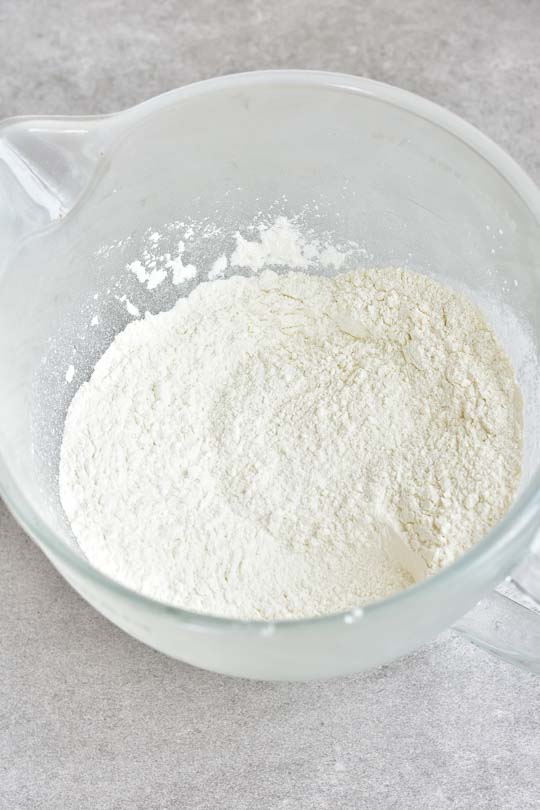
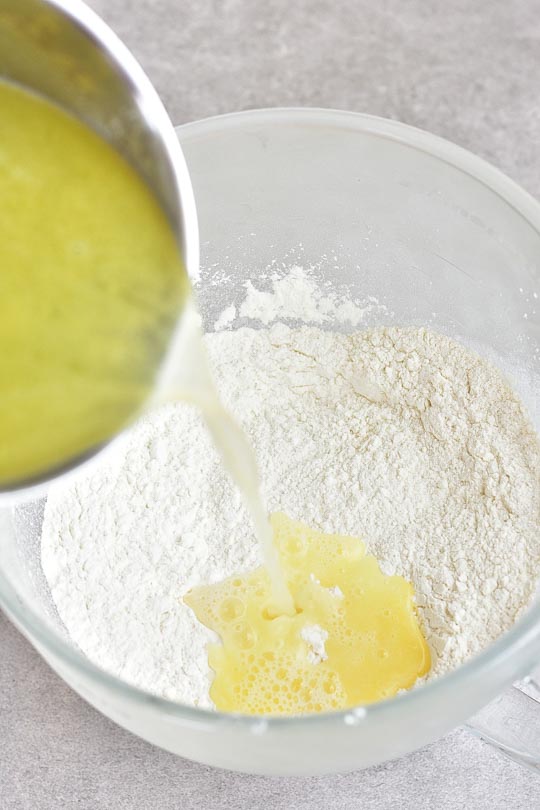


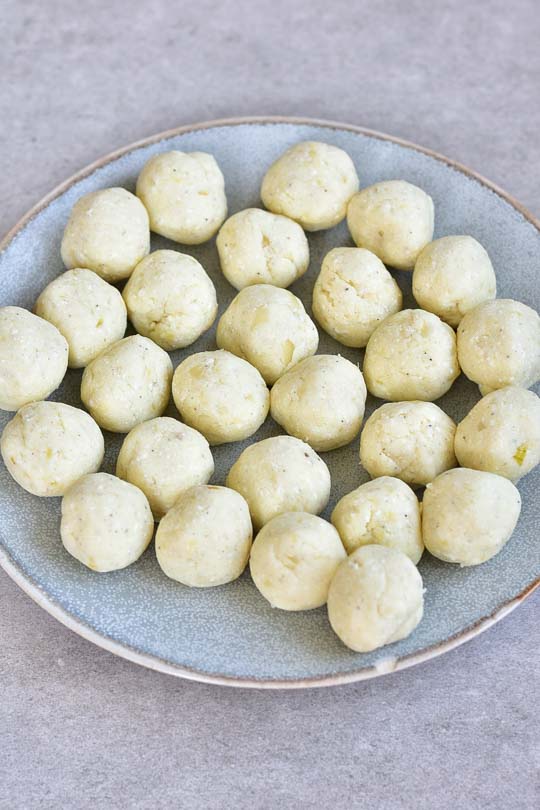
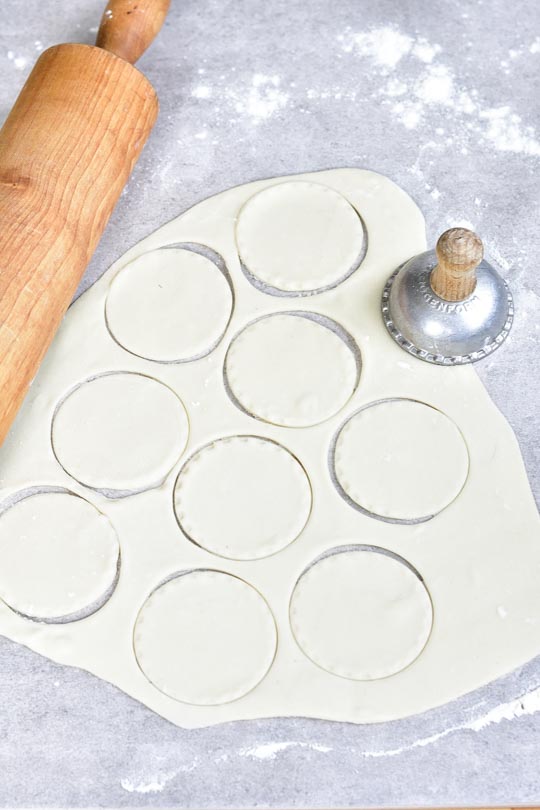
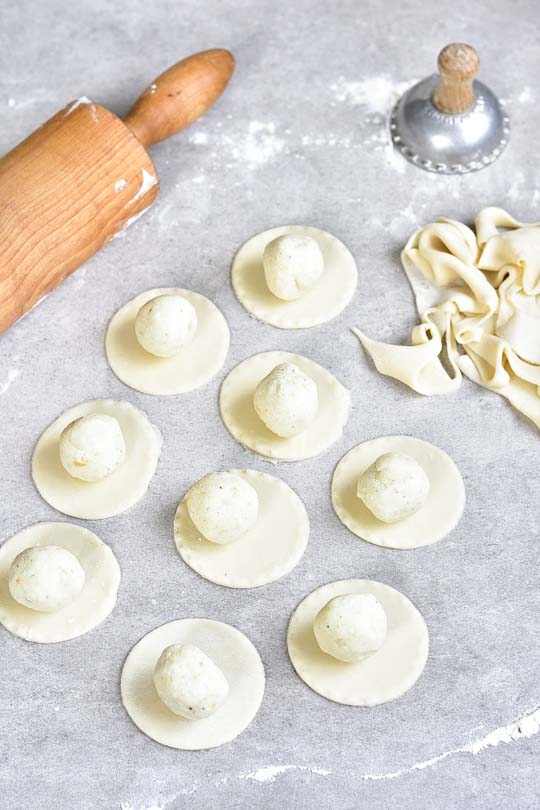
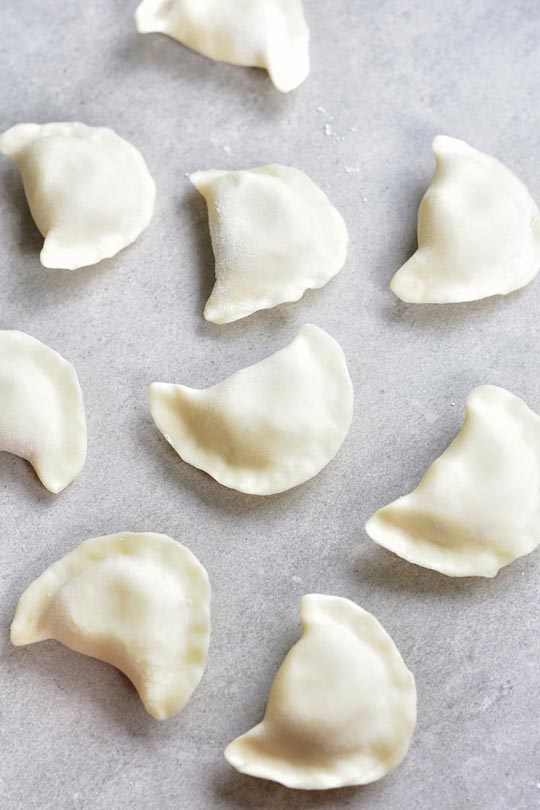
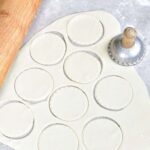
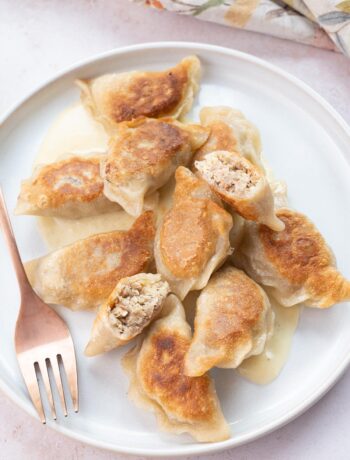
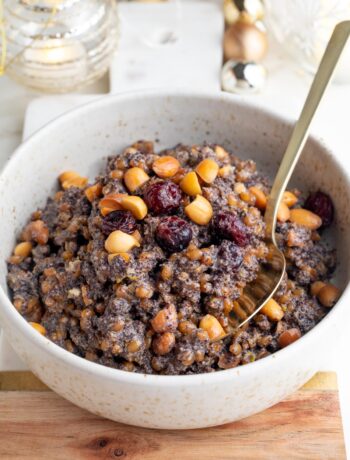

408 Comments
Terri
13 March 2022 at 23:47This is the best recipe for dough EVER!!! Thank you so very much!!!!!
Aleksandra
14 March 2022 at 06:54you’re welcome, I’m glad it worked for you!
Ashley
7 March 2022 at 18:39Looking at the comments, I know I must have done something wrong. I can only think that 190 F for the water was too hot, if I try again I’ll err closer to 170F.
If you have 7 hours to roll and cut the dough, 190F still gives Delicious end results, but I don’t have that long, I have max 2 hours active time before my toddler goes ballistic.
Aleksandra
7 March 2022 at 21:12thank you for your feedback, I will reduce the temperature in the recipe although I personally haven’t had this problem
Christine
6 February 2022 at 13:21Made this dough recipe yesterday with my adult kids. Potato cheese, mushroom and sauerkraut. This dough is the best ever in all the years. Thanks for posting, made it so much easier.
Aleksandra
6 February 2022 at 13:45I’m glad it worked out for you, thank you for leaving the comment!
Jackie G
25 February 2022 at 13:53Grandma never used anything but flour, salt and water. Is the butter what makes the dough so “easy” to work with, as most have said? The dough was always the hardest part of the whole process – rolling.
Aleksandra
25 February 2022 at 14:57yes, butter (or any fat, such as vegetable oil) makes the dough more elastic and easier to work with, it also adds some flavor to the dough, my grandma adds oil but I prefer butter for the flavor
Maggie m
7 January 2022 at 01:30I am absolutely blown away by how GOOD this dough felt. Used a scale (for 1/2 the recipe) and a thermometer and just couldn’t stop telling my partner how good the dough felt to knead and roll. No kitchenaid or pasta maker so I got to feel it all.
Our first time making pierogies and we are calling ourselves masters … except we have not figured out how to seal them so they’re attractive. Oh well … they TASTE fabulous. So tender!
Thank you for being so clear.
And I LOVED kneading the warm dough by hand.
Aleksandra
7 January 2022 at 07:21So glad you liked the recipe, thank you for your comment!
Rich
5 January 2022 at 05:36Really amazing recipe! It was so easy to make, using a scale to get the ratios right and kneading by hand. It was my first time making pierogis, and it was a huge hit at my house. I will be keeping this recipe for future use. Thanks for sharing!
Aleksandra
5 January 2022 at 07:03You’re welcome, Rich, thank you for your comment!
Andrew S
2 January 2022 at 20:59My family love this recipe, we spent all morning on Christmas this year to make 127 pierogi! We really curious where did you get your cutter and what is the size?
Aleksandra
2 January 2022 at 21:49I’m so glad you liked the recipe! I got the cutter from my family, it’s probably 30 years old! It’s 2 3/4 inch(7cm) in diameter.
Amy & Debbie
1 January 2022 at 21:55Thank you Aleksandra,
My mother taught my sister and I how to make Pierogi and we have shared her recipe with family. We have always made our dough by hand the way we were taught but knew our dough was tougher than it should be. We tried your recipe yesterday, and since we received high-ratings from our families, we wanted to thank you for sharing your recipe and steps to making Perfect Pierogi Dough. The difference between the recipes we had as the amount of salt and resting. I used a Kitchen Aid to make the dough. Once made, letting it rest for 30 minutes was also beneficial. We had them for dinner last night and are still receiving praises today. That has never happened before.
Aleksandra
2 January 2022 at 06:53I’m happy to hear that. Thank you for taking time to leave the comment!
Suzana
1 January 2022 at 20:20I just made my perogi. This is the best dough i have ever used!! I usually make a potato dough, it is just too time consuming. They turned out perfect! Thank you so much for this recipe!
Aleksandra
1 January 2022 at 21:18You’re welcome! I’m glad you liked the recipe. Thank you for leaving the comment!
Zara
31 December 2021 at 08:14My grandma never measured, showed me “some of this, some of that” but she is gone now and I was never able to recreate just right until now. This was exactly like grandmas! I even shared the recipe with my adult children so when I am gone, they won’t have to guess at “some of this, some of that” thank you so much. Perfect!
Aleksandra
31 December 2021 at 09:21I’m so glad to hear that, thank you for your comment!
Kirsten
30 December 2021 at 16:28I used this recipe for my Christmas pierogi this year. This dough behaved wonderfully!!! It was easy to knead by hand and did not stick to counter or rolling pin when I rolled it out. It was very elastic and sealed perfectly with just a stroke of water from a wetted finger. Best pierogi dough ever! Thank you, Aleksandra, for the wonderful recipe, thorough and clear instructions and all the additional information!
Aleksandra
30 December 2021 at 18:02You’re welcome, Kirsten. I’m glad you liked the recipe and thank you for taking the time to comment!
Judy Luranc
29 December 2021 at 00:33I can’t believe how good this recipe is without sour cream or egg!. I let it rest and used the hot water, it was tender and flavorful! Made it super easy with my kitchen aid, which saved me as well. I only made one batch, not knowing how it would turn out, but it was amazing. Thanks so much! If you get the recipe for a gluten free one as well, please post!
Aleksandra
29 December 2021 at 09:09I’m glad you liked the recipe! I have not tried making gluten-free pierogi, sorry!
Greg O
24 December 2021 at 19:48Worked perfectly as written, great elasticity in the dough. Weighed the ingredients as recommended. Dzięki!
Aleksandra
24 December 2021 at 19:52I’m glad to hear that, you’re welcome!
Jackie Furman
21 December 2021 at 17:05Do you use salted or unsalted butter?
Aleksandra
21 December 2021 at 17:28Unsalted. You can also use salted, maybe reduce the salt amount a bit.
Ewa
20 December 2021 at 06:48Hi! I’ve been making pierogi for a long time now, but never in the KitchenAid mixer! This is a game-changer!! Just made a batch of your dough for uszka, and it came out amazing! Never going back to old ways! Thank you!!! Merry Christmas!
Aleksandra
20 December 2021 at 11:02I’m happy to help! Thank you for the comment and Merry Christmas to you too!
Bee
29 December 2021 at 07:15Any chance someone has tried this with gluten free flour? Any tips? Or suggestions of flour brands to try with this recipe?? Many thanks
Aleksandra
29 December 2021 at 09:10I have not tried making gluten-free pierogi, sorry!
Irene Jakubow
19 December 2021 at 20:11I will be making my first pierogi dough and would like to use my mixer for kneading .You mention 5 minutes but, at what speed?some help would be greatly appreciated.Given the terrific ratings I would like to make mine perfect as well. Thank you
Aleksandra
19 December 2021 at 20:32Speed 1 at the beginning then 2 with a dough hook attachment (I have a kitchen aid mixer). Pay attention to the consistency of the dough, it should be soft and smooth – this is more important than time, 5 minutes is a rough estimate. Watching the video can also be helpful. Good luck!
Emi
15 December 2021 at 17:46Where are the list of how much I need of each Ingredient??? All I see is the flour??
Aleksandra
15 December 2021 at 18:21it’s in the recipe card at the end of the post: https://www.everyday-delicious.com/the-best-pierogi-dough-recipe-how-to-make-the-best-pierogi-polish-dumplings/#wprm-recipe-container-3051
4 cups flour (500g / 17.5-oz, spooned and leveled)
1 cup + 2.5 Tbsp water (280g / 280ml / 10-oz (to weight on a scale))
3 tablespoons butter (1.4 oz/40g) or vegetable oil
1 teaspoon salt
Laura
10 December 2021 at 05:40Uwielbiam pierogi w każdej postaci. A twoje ciasto jest doskonałe, farsz również. I bardzo cenne wskazówki, pierożki nie mogą się nie udać. Jeśli chodzi o śmietanę piszesz, że nie daje się jej do pierogów. Nie do ciasta, ale moja babcia pochodzące ze Lwowa podawała ją jako dodatek (sos) do pierogów ruskich, gęstą, kwaśną i lekko posoloną. To wersja postna. Zwykle pierogi polewała tłuszczem ze skwarkami z wędzonej słoninki. Pycha. W wigilię na naszym stole tradycją są jeszcze pierogi z nadzieniem z suszonych śliwek faszerowanych orzechami włoskimi i miodem. Są pyszne. Polecam.
Miło pogrzebać w twoich przepisach. Pozdrawiam z Polski i życzę Wesołych Świąt.
Aleksandra
10 December 2021 at 18:04Dziękuję bardzo za miły komentarz. Nigdy nie jadłam pierogów z suszonymi śliwkami – to nadzienie brzmi pysznie, będę musiała spróbować. Pozdrawiam serdecznie, wesołych świąt!
Diane K
5 December 2021 at 17:02Awesome dough recipe, I weighed my ingredients and it came out perfect. Thank you!
Aleksandra
5 December 2021 at 17:19I’m glad to hear that, you’re welcome!
Mavis
4 December 2021 at 23:24Mixed according to directions and weighed ingredients. Dough turned out tough and dry. Letting it rest. Hopefully it turns out!
Aleksandra
5 December 2021 at 10:06It should not be tough and definitely not dry. It will be softer after resting time but if you’re saying that it was dry it tells me that something went wrong. Maybe your water was not hot? Did you take a look at the video?
Judy
7 October 2021 at 01:32This is a great recipe with excellent tips!
I used my scale and yes you are right! It works. The dough is tender and rolls beautifully. I was able to roll my dough so thin I could see the markings on the pastry mat beneath! As well the dough didn’t shrink.
Two batches of dough made 9 dozen Pierogi! And because we are eating our Thanksgiving outside again this year we are having Pierogi and Cabbage Rolls instead of turkey!
Happy Thanksgiving! Thank you for sharing your recipe!
Aleksandra
7 October 2021 at 05:11I’m glad you liked the recipe! Thank you for your comment and happy Thanksgiving!
MoMo
24 December 2021 at 17:00I can’t find any video on making the dough. There are blank spaces in the recipe area. Maybe it’s there and I cannot view it? Can you put a link to it in the replies?
Aleksandra
24 December 2021 at 17:32I’m sorry you couldn’t find it. It’s also here: https://www.youtube.com/watch?v=hB6Ti8wXCq4&list=UUe61tPaR5TGM4AnwmrHudyw&index=34, I’m showing how to make the dough at 0:40.
Aleksandra
24 December 2021 at 17:46The video should now show above the recipe card. I’m sorry, again!
MoMo
27 December 2021 at 00:43Thank you for the video link. It may be my browser that wasn’t letting it appear. But I went ahead and made the dough, following your instructions exactly. I carefully weighed the flour to the precise amount, and added the salt to it. I also carefully measured the water to the amount in the ingredient list and heated it to 190 degrees with the butter in it. The dough would barely come together and was like a ball of clay. I let it rest for about 45 minutes, wrapped in plastic wrap. It was so dense it was difficult to roll out. I tried to make it 1/8 inch thick but it just shrunk back up, so my rounds were obviously too thick, and I was only able to get 38 pierogi out of it. Also it didn’t cook up well. It tasted like uncooked dough on the inside. I think the problem was a lack of water, because you said to weigh all the ingredients. I should have just measured 10 ounces.
Aleksandra
27 December 2021 at 07:01I’m really sorry you’ve had such a bad experience. I’m not sure what could go wrong. My guess would be not enough water but you’re saying that you’ve measured it, so I’m not sure. Was the dough kneaded properly? If you want to give this recipe another go I would just add a little bit more water if the dough is too dry and tough. Also, maybe the water was a little bit too hot? It should be very warm but not too hot, when it’s too hot the dough becomes kind of gluey.